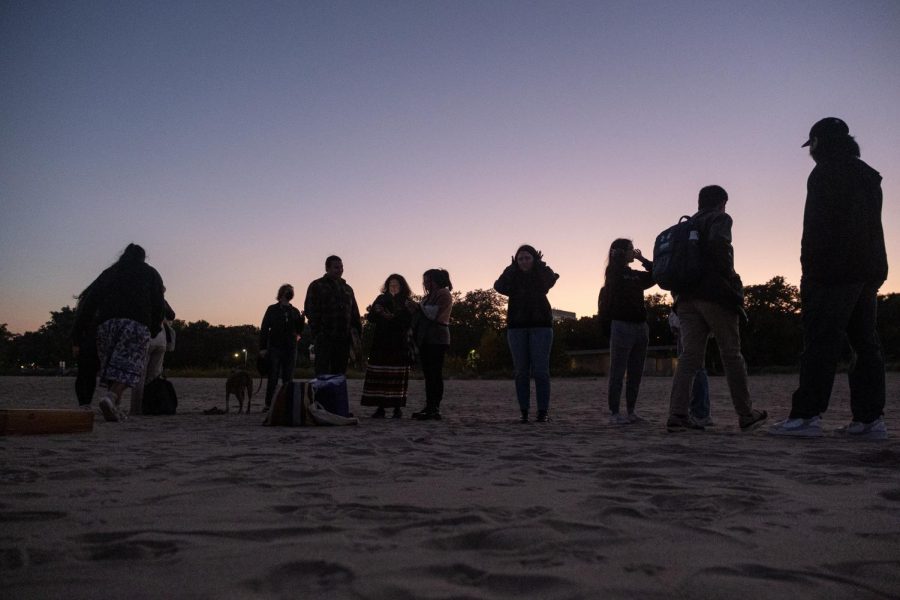NAISA celebrates Indigenous Peoples Day with sunrise and sunset gatherings
Seeger Gray/Daily Senior Staffer
Native and non-Native community members gather at Clark Street Beach for the Native American and Indigenous Student Alliance’s Sunset Gathering.
October 11, 2022
Northwestern’s Native American and Indigenous Student Alliance centered laughter and community in its Indigenous Peoples Day celebration Monday.
Ten people attended NAISA’s Sunrise Ceremony at 6:15 a.m., and about 20 community members, Native and non-Native, attended the group’s Sunset Gathering at Clark Street Beach.
SESP senior and NAISA co-Chair Isabella Twocrow, who is Oglala Lakota and a citizen of the Ho-Chunk Nation, said the Sunrise Ceremony and Sunset Gathering are some of her favorite events all year. While NU’s quarter system demands a breakneck pace and many NAISA meetings have structured agendas, she said, Monday’s community gatherings offered a space to pause.
“Today’s one of those days where we don’t have to worry about (meeting agendas),” Twocrow said, “and we really can just be with each other, check in, hug each other and laugh with each other and not worry about anything else.”
After smudging, community members at the Sunset Gathering caught up with loved ones as the sun disappeared under the horizon and the moon rose above Lake Michigan.
SESP sophomore and NAISA Treasurer Alivia Britton, who is Odawa, attended both events. Hailing from Michigan, Britton would always spend time with her family on Lake Michigan. She said being by the lake with her NU community was a full-circle moment.
“When I was out on the water today, I was thinking of the impact of the water and the fact that my ancestors have been on that and so many other tribal communities have traveled through that same body of water and sand,” Britton said.
For Britton, celebrating Indigenous Peoples Day with community members and allies meant taking care of and supporting one another.
NAISA works to create a caring community, Britton said, by recognizing everyone’s humanity and prioritizing mental health in a school environment that can be competitive.
“It’s nice just to come to NAISA and get away,” Britton said. “I’m very much about grounding myself and reflecting, and this is a space where I can do that and be more appreciative of everything I had and everything I am working towards.”
Communication and McCormick dual-degree sophomore Bella Kirkwood, who is a citizen of the Cherokee Nation and a part of the Delaware Tribe of Indians, said it was her “mission” to connect with other Native people once she got to college, especially since she wasn’t able to do so in her hometown in Kansas.
For Kirkwood, NAISA immediately felt like home.
“I look forward to it every week,” Kirkwood said. “It’s just a nice place to go and to be, and not have to worry about the chaos that is the rest of my life.”
Twocrow said she hopes to build up NAISA for future generations of Indigenous students. After NU community members vandalized The Rock with racist and anti-Indigenous hate speech last fall, the University’s Native community has grown even closer this year, Twocrow said.
NAISA now has a council of six students, its first council ever, to delegate responsibilities and support members. The class of 2026 has one of the largest classes of Native and Indigenous students in NU history, Twocrow said.
The organization hopes to see higher community turnout at events such as the Sand Creek Commemoration and 30 Days of Indigenous in November, as well as the annual powwow in Spring Quarter.
Twocrow said she hopes NAISA is a place that continues to bring people together.
“Laughter is our medicine,” Twocrow said. “I’m always laughing when I’m around these folks, and that means the world to me.”
Email: [email protected]
Twitter: @yimingfuu
Related Stories:
— Not invisible: Students create solidarity and community in NAISA












